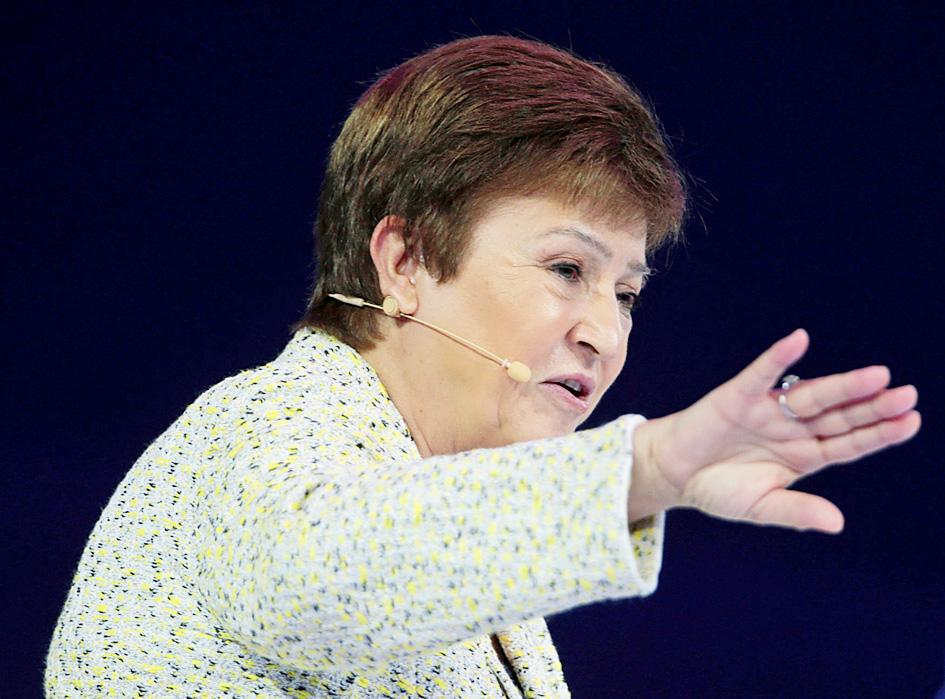Global finance leaders on Tuesday said the world economy had so far escaped a collapse triggered by the COVID-19 pandemic, but warned that failure to conquer the outbreak, maintain stimulus and tackle mounting debt among poor nations could crush a fragile recovery.
At the start of the annual meetings of the IMF and World Bank, the fund issued slightly improved growth forecasts spurred by unexpectedly stronger rebounds from COVID-19 lockdowns in the wealthiest countries and China.
The IMF now forecasts world GDP would shrink 4.4 percent this year, compared with the 5.2 percent drop seen in June, according to the World Economic Outlook released on Tuesday.

Photo: EPA-EFE
For next year, the IMF sees growth of 5.2 percent, down from 5.4 percent.
The report includes revisions to June’s forecasts and other historical data to reflect updated country weightings.
“The story is less dire than we thought three months ago, but dire nonetheless,” IMF managing director Kristalina Georgieva said during a panel discussion that was held virtually.

Photo: Reuters
Georgieva said governments needed to stay focused on their healthcare responses to COVID-19 and must not withdraw stimulus prematurely.
“If we cut these lifelines that have been extended to families and businesses before we are out of the health crisis, this could be catastrophic in terms of bankruptcies, unemployment and undoing all that has been done so far,” she said.
The upward revision in the IMF’s growth forecast for this year reflects in particular better-than-projected second-quarter growth in the US and the eurozone, a stronger-than-expected return to growth in China and signs of a more rapid recovery in the third quarter.
The US economy is projected to contract 4.3 percent this year, compared with a previous 8 percent estimate, the most-improved forecast among major economies.
However, that does not factor in potential additional fiscal stimulus, as US President Donald Trump and Democrats continue to wrangle over measures.
Growth is pegged at 3.1 percent next year, down from a prior forecast of 4.5 percent.
The eurozone is estimated to shrink 8.3 percent this year, compared with the previous 10.2 percent projection, before expanding 5.2 percent next year, down from 6 percent.
Advanced economies overall are seen declining 5.8 percent this year, compared with 8.1 percent previously.
By contrast, the outlook for emerging markets, some with rising infections, has worsened slightly, with a 3.3 percent contraction anticipated for this year, compared with 3.1 percent previously.
China remains the lone major economy estimated to expand, by 1.9 percent this year and 8.2 percent next year.
India saw the steepest forecast reduction, with a 10.3 percent contraction seen for this year, compared with just 4.5 percent previously, after a larger-than-expected second-quarter contraction.
The G20 major economies, in a draft communique seen by Reuters, said the outlook was “less negative” due to the positive impacts from actions already taken, but the recovery would be “uneven, highly uncertain and subject to elevated downside risk.”
“We will sustain and strengthen as necessary our policy response, considering the different stages of the crisis, to secure a stable and sustainable recovery,” G20 finance ministers and central bank governors said in the draft ahead of a meeting yesterday.
The draft also said the G20 would agree to extend a freeze on the servicing of official bilateral debt for poor countries for another six months beyond the end of this year.
That is well short of the year-long extension sought by the IMF, the World Bank and many emerging market nations, but the G20 agreed to review the debt situation in April next year to determine whether another six-month extension would be warranted.
The freeze aims to free up billions of dollars that poor countries can divert to their pandemic health and economic responses.
Additional reporting by Bloomberg

CHIP RACE: Three years of overbroad export controls drove foreign competitors to pursue their own AI chips, and ‘cost US taxpayers billions of dollars,’ Nvidia said China has figured out the US strategy for allowing it to buy Nvidia Corp’s H200s and is rejecting the artificial intelligence (AI) chip in favor of domestically developed semiconductors, White House AI adviser David Sacks said, citing news reports. US President Donald Trump on Monday said that he would allow shipments of Nvidia’s H200 chips to China, part of an administration effort backed by Sacks to challenge Chinese tech champions such as Huawei Technologies Co (華為) by bringing US competition to their home market. On Friday, Sacks signaled that he was uncertain about whether that approach would work. “They’re rejecting our chips,” Sacks

NATIONAL SECURITY: Intel’s testing of ACM tools despite US government control ‘highlights egregious gaps in US technology protection policies,’ a former official said Chipmaker Intel Corp has tested chipmaking tools this year from a toolmaker with deep roots in China and two overseas units that were targeted by US sanctions, according to two sources with direct knowledge of the matter. Intel, which fended off calls for its CEO’s resignation from US President Donald Trump in August over his alleged ties to China, got the tools from ACM Research Inc, a Fremont, California-based producer of chipmaking equipment. Two of ACM’s units, based in Shanghai and South Korea, were among a number of firms barred last year from receiving US technology over claims they have

Taiwan’s exports soared 56 percent year-on-year to an all-time high of US$64.05 billion last month, propelled by surging global demand for artificial intelligence (AI), high-performance computing and cloud service infrastructure, the Ministry of Finance said yesterday. Department of Statistics Director-General Beatrice Tsai (蔡美娜) called the figure an unexpected upside surprise, citing a wave of technology orders from overseas customers alongside the usual year-end shopping season for technology products. Growth is likely to remain strong this month, she said, projecting a 40 percent to 45 percent expansion on an annual basis. The outperformance could prompt the Directorate-General of Budget, Accounting and

BARRIERS: Gudeng’s chairman said it was unlikely that the US could replicate Taiwan’s science parks in Arizona, given its strict immigration policies and cultural differences Gudeng Precision Industrial Co (家登), which supplies wafer pods to the world’s major semiconductor firms, yesterday said it is in no rush to set up production in the US due to high costs. The company supplies its customers through a warehouse in Arizona jointly operated by TSS Holdings Ltd (德鑫控股), a joint holding of Gudeng and 17 Taiwanese firms in the semiconductor supply chain, including specialty plastic compounds producer Nytex Composites Co (耐特) and automated material handling system supplier Symtek Automation Asia Co (迅得). While the company has long been exploring the feasibility of setting up production in the US to address